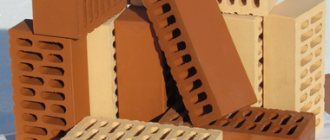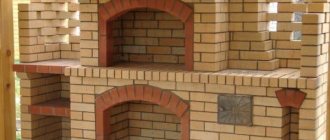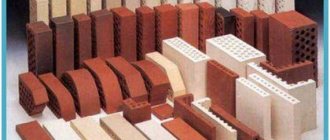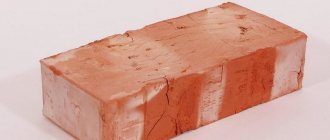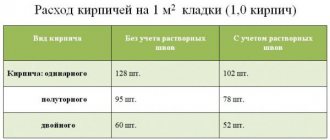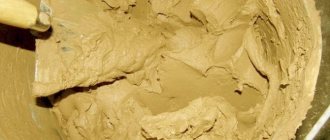Standard sizes of bricks from different materials
The composition and size of the brick is taken into account at the construction planning stage.
In Russia, the parameters of a standard brick (a ceramic product made in the shape of a rectangular parallelepiped) are regulated by GOST 530-2012 and are equal to 250 * 120 * 65 mm (length, width, height). To make the laying easy and the stone convenient to hold in your hand, the creators selected harmonious proportions of all its elements - 1:1/2:1/4. This product format is considered normal and is abbreviated as NF.
Possible deviations from the standard: length – 4 mm, width – 3 mm, height – 3 mm for ordinary and 2 mm for facing material.
Single
This is what is commonly called a brick with dimensions corresponding to the standard. Any elements of various structures are made from it - from the foundation to the walls.
Size marking – 1NF.
A single block varies in strength, which in construction is marked M and the corresponding number. The larger it is, the stronger the material.
Single brick has a standard size.
For example, from single solid brick from M75 to M150 you can build a low-rise residential building. And to build a load-bearing wall or foundation columns, you will need material marked M150.
One and a half
It differs from the previous one only in height - it is 1.4 times larger and amounts to 88 mm.
The size is marked as 1.4NF.
One-and-a-half bricks began to be produced when it was necessary to increase the speed of building houses during total construction.
One-and-a-half differs from single in height.
If you compare it with a standard ordinary block, the difference is almost invisible. But on the scale of constructing a multi-storey building, the savings in time and cement mortar become noticeable.
One-and-a-half bricks produce solid, hollow, facing, ordinary and other bricks.
Double
The main characteristic that distinguishes this block from the standard one is its height – 140 mm. Due to this, construction is significantly easier - you can erect a building exactly 2 times faster, spending half as much as masonry cement mortar.
Double brick contains voids.
Marking – 2.1NF.
Double brick is made from environmentally friendly components - clay, natural fillers and water. Inside it there are voids, depending on the size of which slotted and porous blocks are distinguished.
Walls, foundations, fireplaces, and stoves are made from double blocks.
Modular
There are 2 types of such bricks:
- Single. Its length has been increased to 288 mm, its width to 138 mm, and its height remains the same as that of an ordinary 1NF - 65 mm.
- Thickened. All parameters of this type of block are increased and amount to 288*138*88 mm.
This stone is used to build foundations below the waterproofing layer, walls (external and internal), and plinths.
Euro
The width of such blocks is half a brick less than that of standard ones, and is 85 mm. Therefore, the building material is labeled as 0.7NF. The remaining parameters remain unchanged: length – 125 mm, height – 65 mm.
Euro brick is used as a finishing material.
Euro brick is used by builders as a finishing material. Due to its non-standard width, it is used to decorate house facades, design interiors, and create fencing structures.
Bar
This type of building material includes solid facing blocks with a width of 60 mm and a standard length and height of 250 mm and 65 mm, respectively. They have 2 types of surface – smooth and rusticated (similar to chipped stone, rough) – and a wide palette of shades.
The block is used for decorating the facade of a building and for thermal insulation.
Facing brick size
There is a certain standard for the size of facing bricks, although the dimensions may vary depending on the type of material. Brick can be single or one-and-a-half and performs not only a decorative function, but also protects the building from temperature changes and the negative effects of precipitation.
Dimensions of a single facing brick
Single brick size
Hyper-pressed. High pressure is used for its production and this gives it strength, which is very high in relation to other types. The dimensions of a single facing brick can be as follows: width – 120, 90 and 60 mm. The standard length is 250 mm, and the height is 65 mm.
Ceramic. The production of this type is more complex, since the process is energy-intensive and expensive. During production, a certain temperature regime must be observed. The standard size of this facing brick is: length 250 mm, width 120 mm, and thickness 65 mm. To make the product lighter, it has special voids. They not only make the brick lighter, but also improve the thermal insulation characteristics.
Clinker. Very durable material. In Europe you can find buildings made of this brick that are several hundred years old, but they are still just as attractive. This indicates high strength. Mainly used for cladding facades. High-temperature firing is used, which gives the product uniformity and eliminates the formation of voids. It has the same dimensions as hyper-pressed brick.
One and a half facing brick
The dimensions of the facing one-and-a-half brick are slightly different and are 250 x 120 x 88 mm. In fact, it differs from a single one only in thickness. It is the ideal ratio of technical characteristics and geometric proportions that has ensured this type of brick great popularity.
Produced hollow and solid. The shape of the brick does not affect its dimensions; they remain the same for all types of one-and-a-half bricks. Since brick has high strength, it is used not only for cladding, but also for the construction of structures that are load-bearing. It fits well into the interior, so it is often used inside the house for lining fireplaces and stoves.
Dimensions and weight of bricks by color
Depending on the purpose for which the brick is intended, it will have an individual size and weight.
They are all divided into:
- Construction. They come in red or white.
- Finishing. They are made by adding a variety of colors to the composition.
The weight and dimensions of blocks for construction are larger than those for finishing.
Standard red
This type of building material is made from environmentally friendly raw materials - clay, so it has a rich red color.
Standard red brick has a rich color.
The weight of a red brick depends on whether it is solid or hollow.
A solid single row block (ceramic) has a mass of 3.5 to 3.9 kg and standard dimensions: 250 * 120 * 65 mm.
The hollow one, due to the presence of holes inside, weighs less - from 2.2 to 2.8 kg. Its dimensions are the same as the previous one.
White brick
This is the name of rough sand-lime brick, which is obtained by adding lime and water to sand, so it has a characteristic white color.
By size, solid blocks are divided into:
- Single - correspond to the 1NF marking, weigh about 3.5 kg.
- One-and-a-half - have dimensions of 25 * 12 * 8.8 cm and a weight of 5 kg.
Hollow sand-lime brick weighs less: single - from 2.93 kg, one-and-a-half - from 3.2 kg.
White brick is made from sand and lime.
Facing bricks
The material (solid and hollow) comes in the following dimensions:
- Single – 250x120x65 mm.
- One and a half – 25*12*8.8 cm.
- Euro – 25*8.5*6.5 cm.
In the last few years, Eurobrick has become popular for finishing work, since by using it, the customer can significantly save on cladding.
Solid cladding blocks are rarely used due to their high cost, so they are used to decorate premium-class buildings.
The weight of the material depends on its type, density and size. It ranges from 1.8 to 5.7 kg for solid ones and from 1.5 to 4 kg for hollow ones.
Thanks to the additives, it comes in a variety of colors such as ivory, pearl, terracotta, mocha, honey, etc.
Facing bricks are available in different colors.
Types and sizes of facing bricks
For finishing facades, facing bricks are often used, the dimensions of which differ slightly depending on the manufacturing companies, and the color scheme is determined by the composition of the clay and the presence of specific additives. GOST standards place increased demands on the quality of the outer surface of this finishing material - it should not have chips or cracks. Standards strictly regulate permissible deviations of linear dimensions.
Types of facade bricks according to manufacturing technology
- Ceramic - produced in the form of volumetric bars or with voids, which significantly reduce its specific gravity. Types of decorative surface: smooth, matte, “stone-like” and other materials. An attractive appearance is achieved by coloring the raw materials; external sides of the finished brick (agnobilization), glazing. Hand-molded ceramic products are used in the restoration of ancient buildings.
- Clinker - has low porosity, which is associated with production technology. It is molded from special types of clay, dried and then fired at temperatures up to 1100 degrees. It is moisture-resistant, frost-resistant, durable. The density of hollow brick is 1.6 t/m3, solid brick is 1.95 t/m3, hand-molded is 2 t/m3. The surface can be smooth, rough, corrugated and chipped. Types of clinker in shape: rectangular, trapezoidal, rounded, with cut corners.
- Hyper-pressed - produced without firing, pressing crushed limestone mass under high pressure with the addition of binder cement and dye. At the same time, an incredible resemblance to natural stone is achieved, combined with easy workability. The material is resistant to wear, has an ideal geometry, but does not retain heat well.
Types of finishing bricks by size parameters
Domestic facing bricks, the overall dimensions of which are standard: single, one-and-a-half, and less often double, are in high demand among consumers. The dimensions of a single facing brick are 250x120x65 mm, but there are other size options according to the table.
Single brick type
The table shows the dimensional parameters that meet the European standard. Imported products can be produced in other sizes, ensuring the unique appearance of the building. There is also an American standard, which is characterized by a brick width of 78 mm rather than 120 mm. This type is economical in laying and transporting, it puts less load on the foundation, and does not thicken the walls too much during restoration.
One size of one-and-a-half facing brick (thickness) is 88 mm instead of 65 mm, other parameters are the same as for a single brick. The dimensions of the double brick are 250x120x138 mm, and the long clinker brick is 528x108x37 mm.
Comparative characteristics of facing bricks by cost
The most affordable type of facade brick is an ordinary smooth red block. Changing the color by volumetric dyeing entails an increase in price by 30%. By adding iron to the raw material, many tones of red are obtained - from light to dark. The addition of lime produces white and yellow colors. Different firing conditions produce a variegated color effect. A textured surface costs 20% more than a smooth surface. An unusual shade in combination with a relief is a condition for the relative high cost of facing bricks.
The leaders in terms of price are clinker and hyper-pressed options, which have improved performance characteristics. The most popular varieties in terms of color are traditionally red, as well as yellow. Standard dimensions of facing red brick are 250x120x65 mm. Its shaped varieties with angles at 45° or with rounding are often used. “American” red brick has dimensions of 250x78x65, clinker - according to the above table. For laying red bricks, black or white mortar should be used.
The dimensions of yellow facing bricks, made from limestone with the addition of iron oxide pigment, correspond to standard sizes. The cost varies depending on the relief and brand of cement included in the composition. In contrast to the yellow color of the masonry, brown, red, and black mortar looks great.
Features of wall cladding
- When building a new house, the cladding is carried out simultaneously with the masonry. If the height of ordinary and facade bricks is the same, then construction is carried out in the usual way.
- To calculate the number of rows of cladding, two stacks of stones are placed side by side: one from the facade brick, and the second from the one that goes to the main masonry. When the two stacks are approximately equal to each other, count the number of bars in each of them. The number of stones in the facing stack is equal to the number of spoon rows (bricks are laid in them lengthwise).
To reduce the consumption of facing stones, you can replace some of them with halves, laying regular brick behind them. Bonded rows are placed under the spoon rows and on top of them (across the wall). They are dressing, that is, they connect the masonry to the cladding. The height of the stacks is compared due to the thickness of the solution, which is determined by calculation.
- If a brick with reduced dimensions is used, the mason increases the thickness of the seam from the traditional 8 - 12 mm to 20 mm. Due to this, the height of the internal and decorative walls is equalized. Properly selected dimensions play an important role in the strength of a brick wall. Facing bricks, offered in a wide range, allow not only to give a building a solid appearance, but to make it more durable and reliable.
Brick parameters according to its composition
Bricks are divided into:
- ceramic;
- silicate;
- clinker;
- hyper-pressed.
They contain various natural materials. The scope of application of the blocks and, accordingly, their dimensions depend on this.
Ceramic
It is made from red clay by molding and firing and is used in the construction of multi-story and industrial buildings, so it happens:
- Single with dimensions corresponding to the 1NF marking – 250*120*65 mm.
- One-and-a-half - with a height change of up to 88 mm.
- Double - where h is 2 times the standard - 140 mm.
- Modular – 28.8*13.8*8.8 cm.
Ceramic brick is made from clay.
The minimum weight of solid ceramic bricks for construction is 3.5 kg, hollow ones – 2.2 kg.
If this type of building material is made for facade work, then the words “euro” and “bar” are added to the above dimensions. It weighs from 1.5 kg.
Silicate
It consists of silicate sand (90%), lime (9%) and water. All ingredients are mixed, shaped and “baked” in an autoclave. The result is a very durable material that is used in the construction of buildings and structures. But it also has disadvantages: the block is afraid of water, strong heat and does not save heat well, so it cannot be used to build a stove or foundation on acidic soil.
Sand-lime brick is:
- single – weighing from 3.1 kg for hollow and from 3.6 kg for solid;
- one and a half - from 3.7 kg and 4.2 kg, respectively.
This block does not have Euro or block sizes.
Sand-lime brick is a very durable material.
Clinker
Clinker brick is a ceramic brick made from a special type of clay (chamotte) with the addition of feldspars and clay materials and fired in a kiln at a temperature of +1200ºС.
It is used for facing work or for paving masonry.
Clinker block dimensions:
- 0.5NF – 250*60*65 mm, weight – from 1.2 kg.
- 0.7NF – 250*85*65 mm, from 1.5 kg.
- 1NF – 250*120*65 mm, from 2.2 kg.
- 1.4NF – 250*120*88 mm, from 3.7 kg.
Clinker bricks are fired in a kiln.
Paving clinker does not have standard dimensions. They are determined by the manufacturer independently.
Hyper-pressed
The composition of this type of blocks does not include clay or sand, as in ceramic or silicate ones. By mixing different construction waste (limestone-shell rock, travertine, marble, cement, etc.), original beautiful bricks are obtained, similar to ordinary ones only in shape.
Hyper-pressed material is heavier than ordinary material, so it is rarely used in the construction of buildings: it requires a reinforced foundation and increased material costs.
Dimensions:
- Single 1NF, weight – from 3.8 kg.
- One and a half 1.4NF - from 5.6 kg.
- Euro 0.7NF – from 1.7 kg.
- Bar – from 1.3 kg.
Hyperpressed brick requires a reinforced foundation.
Since the products are not fired during production, their color palette is very wide.
Size chart of bricks by purpose
Each type of this material is used for the construction of objects for different purposes. Depending on how it will be used, there are several types of blocks.
Construction material
Brick for the construction of low- and multi-story buildings and foundations has been used for many hundreds of years, and during this time the best combination of block parameters has been found. They are reflected in GOST 530-2012 and are equal to 250*120*65 mm.
There are 3 options for building bricks:
- Single.
- Double.
- One and a half.
Brick has been used to construct buildings for many years.
Bricks for construction are produced hollow and solid.
Facing brick
It is used to insulate, strengthen and decorate building facades.
Its dimensions:
- 25*12*6.5 cm.
- 25*12*8.8 cm.
- 25*12*13.8 cm.
- 25*8.5*6.5 cm.
Facing bricks are needed for insulation and decoration of facades.
This material is used to build the outer layer of the wall, which will be in direct contact with the environment, so special requirements are placed on its performance characteristics.
For the construction of furnaces
For the manufacture of the furnace, different types of blocks are used, since it consists of several departments, each of which experiences a special load.
For example, the firebox area is exposed to the greatest heat, so fireclay or quartz bricks are required here. The internal chimney channels also heat up, but not so much. Heat-resistant ceramic is suitable here.
To make the stove look aesthetically pleasing, it is covered with facing material.
Tsokolny
To build a basement, the strongest and most waterproof brick is required, since it bears the entire load of the building, and is also exposed to adverse weather conditions - rain, snow.
A silicate block is not suitable for this purpose (it absorbs moisture well and gradually deteriorates), just like a hollow ceramic one. In winter, frost forms in the voids, which turns into water during the thaw. If it freezes again, the ice begins to push the stone apart and destroy it.
Basement brick is the most durable.
It is recommended to make the plinth from ceramic red solid brick of a standard size - 1NF or 1.4NF.
Facade brick
The front side of this material is covered with decorative finishing that imitates natural materials (wood, stone, marble). It has the same dimensions as the facing block.
Fireclay (fireproof brick)
This is the name of a brick made from a special type of fireclay - fireclay, which is fired until it loses its plasticity.
The weight of the product depends on the porosity of the material: the greater it is, the smaller it is.
Modern manufacturers offer a wide selection of refractory bricks of different sizes, which is very convenient when lining stoves and fireplaces: there is no need to saw the blocks.
Fireclay bricks are made from refractory clay.
The most popular dimensions are the following:
- 23*11.4*6.5 cm;
- 25*12.4*6.5 cm.
Fireclay can be rectangular, trapezoidal, wedge-shaped and arched.
Facing brick size, standard
One of the most interesting materials for finishing buildings is facing brick. Thanks to it, the individuality of the building and the originality of its external design are emphasized. This material allows you to create a rich color scheme for a building, imitate it like antique masonry, or highlight the shade. The size of the facing brick plays a significant role in this.
Brick geometry
This material for the external cladding of buildings inherited the basic dimensions of the brick used for laying walls. Wall brick performs load-bearing functions. Therefore, increased demands are placed on its parameters, primarily its dimensions. In Russia and some neighboring countries, a single format of wall bricks of 250x120x65 mm has been adopted. It is called normal or single format. From it originate the modular single, one-and-a-half and double formats, as well as the Euro format. Unlike the brick from which the walls of buildings are erected, the parameters of the facing brick may not coincide with the wall ones. The most common sizes of facing bricks are: 250x120x65 mm (single), 250x120x88 mm (thickened or one-and-a-half) 250*120*138 mm (double). If an ordinary smooth facing brick has a normal format, then a stone-textured brick can be two centimeters shorter. One-and-a-half bricks for cladding also differ in size from the single format. If it is the same in length and width, then its thickness is slightly greater. The dimensions of this artificial stone are 250x120x88 mm. In external facing work, bricks of the so-called “Euro” format 250x85x65 mm (250x85x88) and “American” format 250x60x65 mm or 230x60x65 are also used.
Beyond Standards
Some domestic brick factories offer high-quality clinker bricks in sizes 250x90x65 mm and 250x60x65 mm. In addition, some of the bricks produced are of completely non-standard sizes. So, for large-format bricks for external wall coverings they are 285x85x85 mm. Similar bricks with dimensions of 215x102x62 mm are used. The brick for cladding can be more than twice as long as usual and noticeably thinner - 528x108x37 mm. Leading Dutch and German manufacturers of high-quality finishing bricks supply them in sizes 240x115x71 mm. The popularity of handmade ceramic products is growing. They are offered mainly in sizes 188x88x63 mm. An important feature of finishing bricks is the various options for its geometric shape. This is how textured products are produced with different radii of curvature on one or both sides - the spoon and the butt - the middle and smallest edges of the brick. There are products where a flat surface is used instead of a rounded surface. Such a variety of sizes allows the architect to offer an unusual form of façade masonry, enriching the project with aesthetic diversity.
About the state standard for facing bricks
Finishing a building is the final stage of its construction. Therefore, satisfaction with the appearance of a new or reconstructed object often depends on the materials used here and their quality. Therefore, artificial stone for cladding should not have any flaws and serve not only the function of decoration. It should protect the walls from temperature changes, helping thermal insulation structures provide additional moisture resistance. Therefore, such a material must meet uniform standards for the strength and heat resistance of wall materials.
Today, such requirements are contained in the interstate standard GOST 530-2012, which applies to Azerbaijan, Armenia, Kazakhstan, Kyrgyzstan, Moldova and Tajikistan. As a national standard of the Russian Federation, it came into force on July 1, 2013. This document applies to ceramic stones and bricks that are used for wall masonry and finishing of construction projects. It complies with the main provisions of the regional standards of the European Union in this area, which determine technical conditions, acceptance procedures, and testing methods for products.
What do manufacturers guarantee?
The Qbricks quality standard meets the requirements of this interstate standard. It has recently appeared in Russia and is provided by an association of sellers of ceramics for construction. Products that have received the certificate of this standard are manufactured at the most advanced European and domestic enterprises. Their quality is controlled at all production operations in logistics processes. The entire technological cycle of manufacturing, loading, transportation and storage is accompanied by external experts. This unique quality mark is put on their bricks by the most famous manufacturers who have been producing building materials since the century before last. Many Russian and foreign manufacturers are developing their own standards. Their increased requirements allow the manufactured products to attract buyers with their quality.
Dimensions and weight of bricks according to their filling
Based on their fullness, bricks are usually divided into solid and hollow.
Full-bodied
There are no voids in the structure of this type of material, so it is considered the most durable and is used in the construction of walls and bases.
Solid brick does not contain voids.
On average, the weight of a solid brick ranges from 3.5 to 4 kg. Its sizes are standard - 1NF, 1.4NF, 2.1NF.
Hollow
This is what they call a block with cavities inside. These holes are round, oval, rectangular.
Its mass is always less than that of a full-bodied fish of the same size. The difference is approximately 1 kg.
Dimensions:
- Single – 250*120*65 mm, from 2.3 kg.
- One and a half – 250*120*88 mm, from 3 kg.
- Double – 250*120*140 mm, from 4 kg.
It is most convenient to work with bricks weighing no more than 5 kg.
